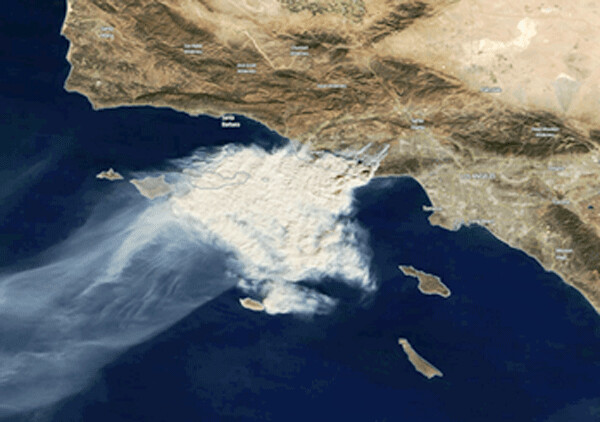Woolsey Fire Started at Santa Susana Field Lab - Site of “[fourth] largest release of iodine-131 in the history of nuclear power”

In my Nov. 15 column, I reported on potential radiation risks posed by the Woolsey wildfire having burned over parts or all of the Santa Susana Field Laboratory, south of Simi Valley, Calif., 30 miles outside Los Angeles, site of at least four partial or total nuclear reactor meltdowns.
The field laboratory operated 10 experimental nuclear reactors and conducted rocket engine tests. In his 2014 book Atomic Accidents, researcher James Mahaffey writes, “The cores in four experimental reactors on site … melted.” Reactor core melts always result in the release of large amounts of radioactive gases and particles. Clean up of the deeply contaminated site has not been conducted in spite of a 2010 agreement.
Los Angeles KABC-7 TV reported Nov. 13 that the Santa Susana lab site “appears to be the origin of the Woolsey Fire” which has now torched over 96,000 acres. And Calif Public Radio said “According to Cal Fire, the Woolsey Fire started on the afternoon of Thursday, Nov. 8 at E Street and Alfa Road, on the Santa Susana site.”
In the 11/15 column I noted that Dr. Arjun Makhinaji, President of the Institute for Energy & Environmental Research, estimated that the 1959 meltdown of the lab’s Sodium Reactor Experiment (SRE) was “the third largest release of iodine-131 in the history of nuclear power,” according to Gar Smith in his 2012 book Nuclear Roulette.
But Makhijani was speaking in 2006, so now of course the SRE meltdown counts as the fourth largest radio-iodine release - after the triple meltdowns at Fukushima in Japan in 2011, Chernobyl in Ukraine in 1986, and Windscale in England in 1957.
Santa Susana’s operators caused the partial meltdown of the liquid sodium-cooled SRE on July 12, 1959—“showering the downwind hills and meadows of the 2,850-acre site with a fog of chromium and radioactive isotopes, including iodine-131,” according to Nuclear Roulette. It was these hills and meadows that were burned so completely by the Woolsey wildfire.
“It [the fog of isotopes] likely spread to nearby communities such as Simi Valley, Chatsworth and Canoga Park,” according to Southern Calif. Public Radio’s Elina Shatkin (“What Happened at the Santa Susana Nuclear Site During the Woolsey Fire?” Nov. 13.) Makhijani calculated that fallout from the meltdown contained “80 to 100 times the amount of iodine-131 released at Three Mile Island” [in Harrisburg, Penn., in 1979], Smith reports in Nuclear Roulette. Canoga Park Senior High School is one of four Red Cross evacuation centers for the Woolsey Fire.
During the two weeks after the partial meltdown of the SRE, workers tried to repair it. “When they couldn’t, they were ordered to open the reactor’s large door, releasing radiation into the air,” Shatkin reported for public radio.
Radioactive materials released by the meltdown were never accurately measured in part because monitors inside the SRE went off scale. Yet the melting of fuel didn’t cause the only releases of radiation from SRE -- just the single largest. According to Joe Mangano in his 2012 book Mad Science, “Every day, radioactive gases from holding tanks in the reactor building were released into the air -- often at night … sometimes twice a day.” In Atomic Accidents, Mahaffey describes the same practice writing, “The fission gases were piped off and compressed into holding tanks for controlled release into the environment…”
After the July meltdown was halted, Atomics International, which ran the SRE, concocted a report for the Atomic Energy Commission on Aug. 29, 1957. The report falsely declared that “No release of radioactive materials to the plant or its environs occurred and operating personnel were not exposed to harmful conditions.”
However, conditions inside the reactor building were extremely dangerous for workers, and radiation levels are estimated to have reached between 10,000 and one million times greater than normal. According to one worker, staff radiation measuring badges were taken away. John Pace, a young trainee at the lab, “Before July 13, we wore film badges, and after then, at some point they [Atomics International] took them away, since they know that the levels would be really high.”
With 10 experimental reactors, radiation routinely released to the air, years of accidents, and four core meltdowns, the “downwind hills and meadows” can be considered permanently compromised with cancer-causing toxins. Dan Hirsch, president of Committee to Bridge the Gap, a nuclear policy organization told public radio that Santa Susana’s soil has, “a mix of radioactive materials like plutonium, strontium-90 and cesium-137” and perhaps 100 toxic chemicals “such as PCBs, dioxins, heavy metals like mercury and chromium-6 and volatile organic compounds like PCE.” In 2012, the US EPA reported that its soil tests found radioactive cesium-137 at 9,328 times ordinary background levels.
Citizens living in the vicinity of Santa Susana have become harshly critical of the site’s early operators - Boeing, Atomic International and Rocketdyne - who for years burned toxic and radioactive wastes in open pits, endangering all the downwinders. In 2005, Boeing paid $30 million to compensate nearby residents for early mortalities and a range of rare diseases.